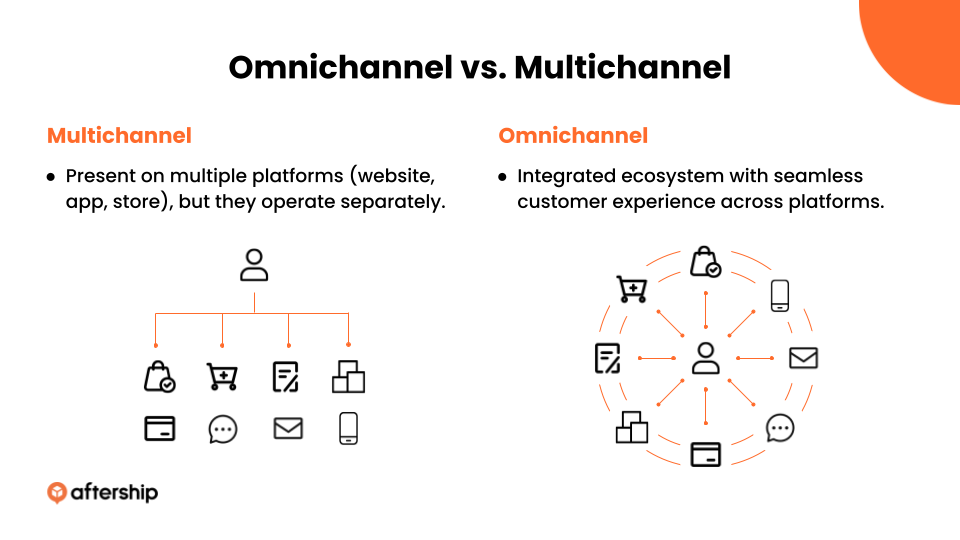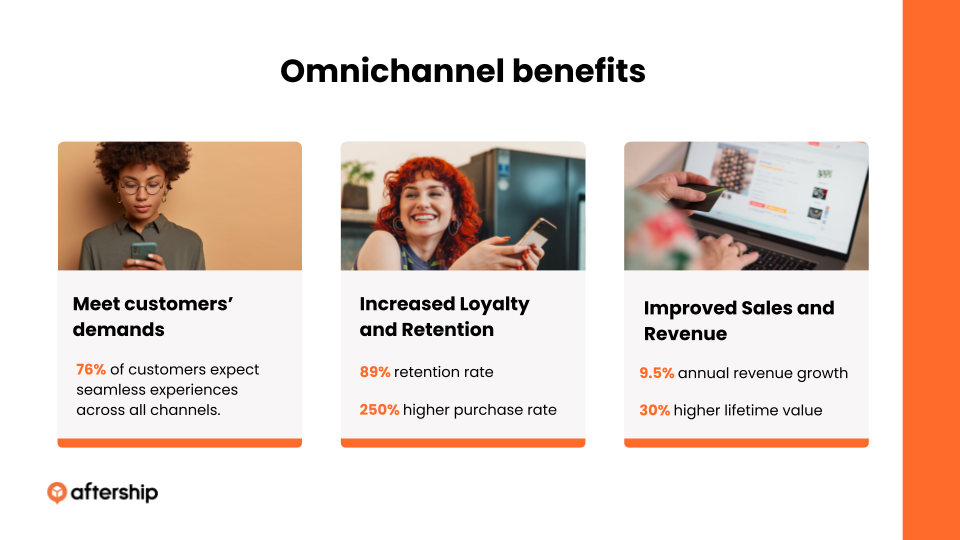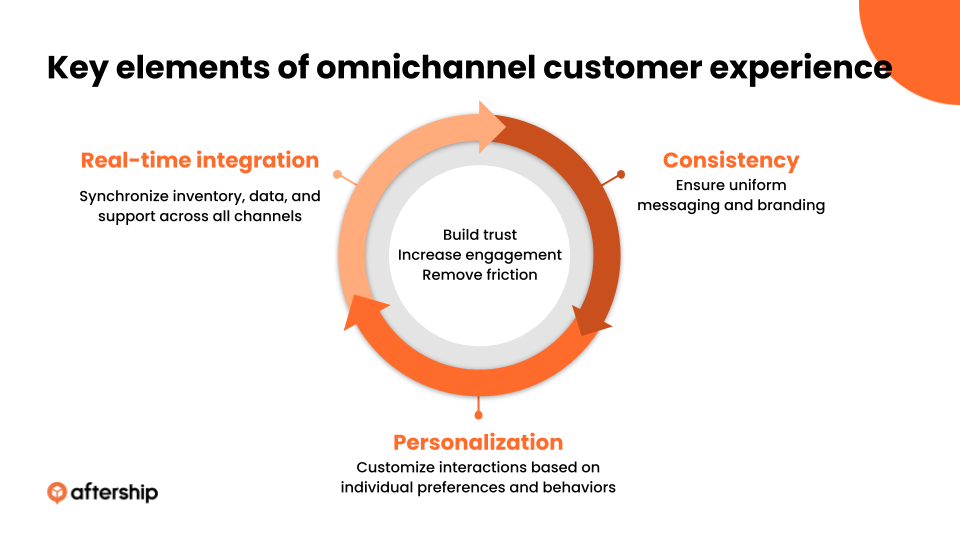Why Omnichannel Customer Experience is Crucial for eCommerce Growth: A Complete Overview
If you’re ready to stop losing your customers to disjointed experiences and start building a brand that feels everywhere without feeling chaotic—keep reading. Let’s turn your eCommerce operation into a growth machine.

Table of Contents
What is Omnichannel Customer Experience?
- A Simple Definition of Omnichannel Customer Experience
- Omnichannel vs. Multichannel: Why the Difference Matters
Why Omnichannel Customer Experience is Crucial for eCommerce Businesses
- Customer Demand for Seamless Experiences Across All Channels
- How Omnichannel Increases Loyalty and Retention
- The ROI is Clear: Omnichannel Pays Off
Key Elements of Omnichannel Customer Experience
- Consistent Branding and Messaging: The Trust Anchor
- Personalization: The Secret Sauce
- Real-Time Integration: The Backbone
How Omnichannel Customer Experience Improves Customer Journey
How to Implement Successful Omnichannel Customer Experience Strategies in eCommerce
Best Practices for Implementing Omnichannel Customer Experience in eCommerce
- Map the Customer Journey with Warby Parker
- Unified CRM Integration: How Zappos Delivers Legendary Service
- Cross-Platform Support: Seamless Shopping Experience of Nordstrom
Common Challenges in Omnichannel Customer Experience
Picture this: A customer browses your mobile app on their phone during their commute, adds a product to their cart, but gets distracted. Later, they open your website on their laptop and see the same cart waiting for them—along with a personalized discount nudging them to complete the purchase. It’s the magic of omnichannel customer experience, and it’s rewriting the rules of eCommerce.
Here’s the reality: 73% of shoppers use multiple channels throughout their purchasing journey, yet only 8% of businesses say their online and offline systems are seamlessly integrated. That gap isn’t just inconvenient—it’s costing loyalty, sales, and growth. Today’s businesses can’t afford to offer fragmented journeys. To meet rising expectations, they need to ensure frictionless transitions, whether customers are browsing a product on their phone, interacting with your brand on social media, or walking into your store.
Omnichannel isn’t just a trendy buzzword but a non-negotiable for eCommerce growth, and you can implement this strategy to enhance customer satisfaction, drive loyalty, and ultimately lead to a stronger bottom line. If you’re ready to stop losing your customers to disjointed experiences and start building a brand that feels everywhere without feeling chaotic—keep reading. Let’s turn your eCommerce operation into a growth machine.
A reliable tool to auto-sync products, inventory, and orders between TikTok Shop and major eCommerce platforms. It simplifies product listing, protects revenue, and streamlines order management.
What is Omnichannel Customer Experience?
A Simple Definition of Omnichannel Customer Experience
Let’s cut through the noise: omnichannel customer experience isn’t about being everywhere—it’s about being everywhere seamlessly. At its core, omnichannel customer experience refers to a strategy that integrates every customer interaction—website, app, email, SMS, marketplace, social media, physical store, or chatbots—into a cohesive journey. Think of it as a symphony, where every touchpoint plays in harmony without missed cues or jarring transitions. Just a smooth, intuitive flow that follows the customers wherever they go.
Omnichannel vs. Multichannel: Why the Difference Matters
Many confuse omnichannel with multichannel strategies, but here’s the critical difference:
- Multichannel means you’re present on multiple platforms (website, app, marketplace, store), but they operate in silos. For instance, a customer’s cart on your app doesn’t synchronize with your website, and their in-store purchase history isn’t visible to your support team. It’s like having ten radios playing different songs in the same room—chaotic and disjointed.
- Omnichannel integrates every channel into a single ecosystem. For example, if a customer adds a shirt to their cart on your mobile site, it’ll be waiting in their account when they log into your app. If a customer starts a chat with your AI bot and then switches to a phone call, the human agent should instantly see the chat history. No repeating details and no dead ends. This level of integration is what makes omnichannel so customer-centric.

Why Omnichannel Customer Experience is Crucial for eCommerce Businesses
Let’s get real: customers aren’t just shopping online or in-store anymore. They’re doing both—often in the same transaction. A shopper might research products on your mobile app, compare prices via live chat, and then pick up their order curbside. Thus, seamless omnichannel customer experiences aren’t optional—they’re the currency of modern eCommerce.
Customer Demand for Seamless Experiences Across All Channels
In today’s hyper-connected world, your customers expect a seamless experience across both online and offline. According to a report from Salesforce, 76% of customers expect consistent integrations across multiple channels. Whether they’re browsing your website, shopping in-store, or reaching out for customer support, they want to pick up where they left off. The omnichannel experience meets these demands, giving customers the freedom to interact with your brand however they choose without feeling like they’re starting over at each touchpoint.
How Omnichannel Increases Loyalty and Retention
Consistency isn’t just about branding colors or logos. It’s about delivering the same level of service, messaging, personalization, and accessibility whether a customer is scrolling TikTok or standing in your checkout line.
- Brands with strong omnichannel strategies retain 89% of their customers, compared to 33% for those with weak strategies.
- Customers who engage with three or more channels have a 250% higher purchase rate than single-channel users.
Omnichannel customer experiences make customers feel valued and build a positive relationship, resulting in increased satisfaction and, ultimately, loyalty. When a customer’s cart, preferences, and history follow them across devices, they’re more likely to convert continuously—and less likely to bounce to a competitor.
The ROI is Clear: Omnichannel Pays Off
Companies investing in omnichannel strategies see:
- 9.5% annual revenue growth vs. 3.4% for laggards.
- 30% higher lifetime value from omnichannel customers.
Even better: omnichannel shoppers spend an average of 10% more online and 4% more in the store compared to single-channel buyers since every integrated touchpoint—personalized emails, in-store recommendations, post-purchase surveys—builds a deeper connection.

Key Elements of Omnichannel Customer Experience
To create a successful omnichannel strategy, you need to focus on three core elements:
1. Consistent Branding and Messaging: The Trust Anchor
Your website says “premium luxury,” but your email campaigns scream “flash sale frenzy.” This can confuse customers. Maintaining consistent branding, tone, values, and messaging across every platform reassures customers and builds trust.
2. Personalization: The Secret Sauce
“Hey [First Name]” emails won’t cut it anymore. True personalization means tailoring experiences based on behavior, purchase history, and real-time intent. Imagine that a customer abandons a cart on your app, and then receives a push notification with a discount and a link to a related blog post addressing their hesitations.
3. Real-Time Integration: The Backbone
Nothing kills trust faster than a website saying “In Stock” when your store shelves are empty. Real-time integration synchronizes inventory, customer data, and support interactions across all channels, allowing for immediate responses to customer queries, faster order fulfillment, and overall improved service delivery.
How These Elements Work Together
Consistency builds trust, personalization deepens engagement, and real-time integration removes friction. Together, they create a flywheel effect:
- Consistent branding: A customer sees a TikTok ad, then encounters the same message and visuals in an email or on your website.
- Personalization: They visit your site, where AI recommends products based on the Instagram posts they’ve opened or the brand accounts they’ve engaged with.
- Real-time data: They buy online and pick up in-store, where the associate already knows their preferences.

How Omnichannel Customer Experience Improves Customer Journey
Let’s explore how omnichannel transforms the customer journey from chaotic to cohesive:
The Omnichannel Journey: From Discovery to Delight
A typical customer journey today isn’t linear—it’s a web of touchpoints. Here’s how omnichannel weaves them into a unified path:

- Discovery: Shoppers first find your brand through a social media ad or an influencer partnership. They click the “Shop Now” link, which leads them to your website or app.
- Research: On your website, they browse products, read reviews, and compare prices. They add items to their cart but don’t purchase just yet.
- Engagement: The customer receives a personalized push notification on their mobile app, reminding them of their saved cart items and offering a limited-time discount.
- Conversion: The customer decides to visit your physical store to check out the products. They use the store locator on your app and are greeted by a sales associate who recognizes them through their loyalty account, ensuring they have a consistent in-store experience.
- Post-Purchase: After the purchase, the customer receives an email with order tracking information and a personalized thank-you message, along with suggestions for related products and an easy-to-access return option in case the product doesn’t meet expectations.
This is the essence of omnichannel: a frictionless journey across different platforms that feels like a unified experience. As customers move from one touchpoint to the next, they encounter no interruptions, leading to higher satisfaction and a stronger likelihood of repeat purchases.
Data: The Fuel for Frictionless Journeys
Omnichannel thrives on data—not just collecting it, but using it. Brands that leverage customer behavior across channels can:
- Predict needs: If a user spends 10 minutes on your “organic skincare” page, send them a guide to transitioning from chemical products.
- Preempt issues: If you spot a repeat-returns customer, trigger a live chat offering sizing assistance before their next purchase.
- Personalize in real-time: Target app users who browsed running shoes with a push notification about a local marathon event.
Omnichannel customer experience isn’t just smoothing edges—it’s rebuilding the entire journey around the customer. When every touchpoint is connected, you’re not just selling products. You’re building a narrative where the customer feels guided, not marketed to.
How to Implement Successful Omnichannel Customer Experience Strategies in eCommerce
Here’s your step-by-step playbook to turn siloed channels into a growth engine:
1. Map the Customer Journey
Start by mapping your customers’ journeys across all touchpoints. This includes online channels like your website, mobile app, social media, and email, as well as offline channels like physical stores and customer service. Plot every step: discovery (social media), consideration (blogs, reviews), purchase (app, website), and post-purchase (support, loyalty programs). Understanding how customers move between these channels will help you identify gaps and optimize the overall experience.
2. Integrate a Unified CRM
Your Customer Relationship Management (CRM) isn’t just a database—it’s the brain of your omnichannel strategy. Brands using CRM see a 29% increase in sales and 34% higher customer retention. A unified CRM stitches data together from every channel: email opens, app logins, support tickets, and in-store purchases, ensuring your team can access accurate, real-time information across all channels. This data is invaluable for personalizing the experience and ensuring consistency in customer interactions.
3. Launch Cross-Platform Customer Support
Customers today expect quick, effective support no matter where they are. Ensure that your customer support is integrated across all channels, whether it’s live chat on your website, social media, or in-store assistance. Cross-platform customer support ensures that customers don’t have to repeat themselves when moving from one channel to another, making their experience smoother and more satisfying.
Best Practices for Implementing Omnichannel Customer Experience in eCommerce
Some brands have already successfully implemented omnichannel strategies. Let’s look at a few examples:
1. Map the Customer Journey with Warby Parker
Warby Parker’s “Home Try-On” program allows users to select five frames online, ship them for free, test them at home, and return or purchase in-store or via the app. Every touchpoint—from discovering the home try-on offer through targeted social media ads to adjusting orders via live chat—is designed to support a seamless trial experience. By mapping key interactions (like sending email reminders for unpurchased frames or offering personalized follow-ups after the home try-on), Warby Parker builds trust and gently guides users from initial interest to purchase—online or in-store.
2. Unified CRM Integration: How Zappos Delivers Legendary Service
Zappos built its reputation on hyper-personalized service, leveraging a centralized CRM system that tracks every interaction—order history, call transcripts, and even niche preferences (like a shopper’s love for neon sneakers). This comprehensive approach enables their customer loyalty team to access a customer's complete profile instantly. This seamless integration empowers Zappos to surprise customers with proactive solutions, such as allowing returns without requiring any explanations or providing tailored product suggestions based on previous purchases.
3. Cross-Platform Support: Seamless Shopping Experience of Nordstrom
Nordstrom integrates its customer support across digital and physical platforms, ensuring a smooth and unified shopping journey. According to Nordstrom’s press release on “Wonder All the Way: Nordstrom Holiday Season,” this seamless operation allows customers to initiate a return via the mobile app, complete the process in-store, and receive follow-up updates through email, all with consistent, real-time information shared across all channels.
Common Challenges in Omnichannel Customer Experience
Let’s be honest: Building an omnichannel customer experience isn’t all smooth sailing. Here’s how to tackle the most common hurdles—and turn them into competitive advantages.
Data Silos: The Silent Growth Killer
The Problem: Your marketing team uses one CRM, sales track orders in another, and support relies on spreadsheets. Data silos fracture customer insights, leading to inefficiencies and disjointed experiences, for example, sending a “We miss you!” email to a customer who just complained on social media.
The Fix:
- Invest in a Customer Data Platform (CDP): Tools like Segment or Tealium unify data from apps, websites, POS systems, and more into a single profile.
- Automate workflows: Use Zapier or Microsoft Power Automate to synchronize data across tools. For example, connect your eCommerce platform to your email service to trigger post-purchase follow-ups.
Inconsistent Customer Service
The Problem: A customer emails about a defective product, then calls support—only to repeat the entire story. If customer service is disconnected between channels, it can lead to frustration. Inconsistent service erodes trust and fuels churn.
The Fix:
- Adopt software to facilitate omnichannel | : Platforms like AfterShip Tracking or Returns centralize tracking and returns data in one dashboard, giving support teams real-time visibility and full customer context to deliver faster, more consistent service across every channel.
- Train teams to think omnichannel: Role-play scenarios where agents use CRM data to say, “I see you messaged us on Instagram yesterday—let’s resolve this now.”
Online/Offline Inventory Wars
The Problem: Your website says a product is in stock, but your store sold out hours ago. Inaccurate stock data can cause friction in the customer experience.
The Fix:
- Deploy real-time inventory management tools: Platforms like Cin7 or Shopify POS synchronize stock levels across warehouses, stores, and online.
- Enable “Buy Online, Pick Up In-Store” (BOPIS): The BOPIS feature can increase same-store sales because customers trust accurate stock visibility.
Yes, omnichannel customer experience challenges are real—but so are the solutions. Start by auditing your biggest pain points, prioritize fixes with the highest ROI (like killing data silos), and iterate. Remember: Every hurdle you clear puts competitors further behind.
The Role of Technology in Omnichannel Customer Experience
Technology is a key enabler of omnichannel success. Here’s how the right tech stack transforms fragmented channels into a profit-driving machine.
CRM & CDP Systems: The Brain of Omnichannel
Your CRM (Customer Relationship Management) and CDP (Customer Data Platform) are the dynamic duo behind seamless experiences.
- CRM tracks interactions: purchases, support tickets, and email opens.
- CDP unifies data from apps, websites, POS systems, and ads into a single customer profile.
AI-Powered Tools: The Personalization Engine
Artificial Intelligence isn’t just for science fiction. It’s the secret to predicting what customers want before they ask.
- Chatbots & Virtual Assistants: Handle routine queries (e.g., “Where’s my order?”) 24/7, freeing agents for complex issues.
- Predictive Analytics: Tools like AfterShip Personalization analyze browsing behavior to recommend products.
- Machine Learning: Systems like Spotify recommendation algorithms that learn from past purchases to surface relevant content.
Inventory Management & Order Management Systems (OMS): The Backbone
Nothing kills trust faster than selling out online when your warehouse has stock.
- Real-Time Inventory Systems synchronize stock levels across every channel.
- OMS Platforms unify orders from websites, marketplaces, and stores into one dashboard.
Data Analytics: The Compass
Omnichannel isn’t a “set it and forget it” strategy. Tools like Google Analytics, Mixpanel, and Power BI show you:
- Which channels drive the most engaged customers.
- Where customers hit roadblocks (e.g., mobile app crashes during checkout).
- How offline interactions (in-store purchases) influence online behavior.
Technology isn’t just the “how” of omnichannel customer experience—it’s the only way to scale personalization, accuracy, and speed. Start with a unified CRM and CDP, layer in AI for smarter engagement, and let inventory systems handle the grunt work.
Future Trends in Omnichannel Customer Experience
Let’s unpack the trends reshaping eCommerce and how to future-proof your strategy.
AI-Driven Predictive Personalization
AI is evolving from reactive to predictive. Instead of recommending products based on past purchases, analyzing real-time behavior (social media likes, weather data, and even calendar events) to anticipate needs will be the future trend.
AR/VR for Immersive Shopping
Augmented Reality (AR) and Virtual Reality (VR), like virtual try-ons, 3D product previews, and virtual stores, are erasing the line between digital and physical.
Voice Commerce & Conversational AI
Voice search isn’t just for weather updates. By 2025, voice shopping is projected to hit $40 billion, driven by smart speakers and AI assistants. Customers will order products, track deliveries through chatbots, and resolve issues using voice commands. Additionally, conversational AI (like ChatGPT) will handle complex queries, like comparing products or troubleshooting—without human intervention.
Comments ()